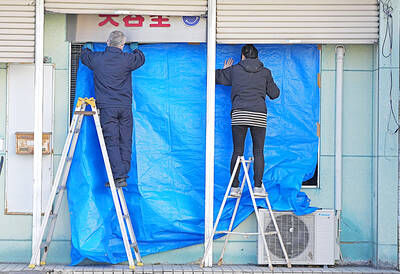The Environmental Protection Administration’s (EPA) garbage incineration policy has come under fire from environmental groups, who said that the processing of industrial waste is being prioritized over household waste and is contributing to the garbage crisis in central and southern municipalities.
Taiwan Watch Institute secretary-general Herlin Hsieh (謝和霖) said EPA policy benefits incineration plant operators by allowing them to accept industrial waste, adding that operators can charge more for the processing of industrial waste.
The EPA has constructed 26 incineration plants under its “one incineration plant for each municipality” policy, but one plant in Taitung County and another in Yunlin County have yet to start operation.
The overall design capacity of the 24 plants in operation is 24,650 tonnes of garbage per day, while those plants actually process 17,245 tonnes — including household and industrial waste — every day, the EPA said, adding that the processing of household garbage accounts for 45.68 percent of the design capacity.
Hsieh said that with about 55 percent of the design capacity not being utilized, the garbage crisis should never have happened.
“The problem lies with the EPA’s decisionmaking and its inability to coordinate local governments, while it allows plants designed for processing household garbage to accept industrial waste,” he said.
Incineration plants can earn more than NT$1,000 for every tonne of household garbage from other municipalities that they process, while they can earn between NT$1,500 and more than NT$2,000 for processing 1 tonne of industrial waste, making industrial waste more attractive, Hsieh said.
He said that there are three privately managed plants, five public plants and 16 other facilities constructed by the EPA that have been transferred to local governments and run by private companies.
“The 21 government-funded plants should prioritize household garbage over industrial waste, instead of benefiting plant operators at the taxpayers’ expense,” he said.
The institute called for the establishment of a minimum processing fee for industrial waste, as a Kaohsiung plant charged only about NT$400 per tonne for industrial waste and broke down after excessive and untreated trash was dumped at the plant.
“The EPA should collect and redistribute all the earnings of the 24 plants to compensate those plants that mostly process household garbage as a more efficient incineration policy,” Hsieh said.
Citizen of the Earth office director Tsai Chung-yueh (蔡中岳) said the government is strict about household garbage management with the “per bag trash collection fee” to reduce garbage, but it continues to offer discounted processing fees to private companies, which are unlikely to reduce their garbage output if the processing fee does not rise.
Bureau of Environmental Inspection Director-General Hsiao Ching-lang (蕭清郎) said the 24 plants processed 6.42 million tonnes of garbage last year, 65 percent of which was household garbage and 35 percent industrial waste, which was a regular distribution between the two types of trash.
He said industrial waste could crowd out the space for household garbage, as the processing cost of public incineration plants is lower than private incinerators — usually with a capacity of 100 tonnes per day.
However, each plant belongs to a local government, and it is up to the local governments to designate trash processing fees, he said.

Taiwanese were praised for their composure after a video filmed by Taiwanese tourists capturing the moment a magnitude 7.5 earthquake struck Japan’s Aomori Prefecture went viral on social media. The video shows a hotel room shaking violently amid Monday’s quake, with objects falling to the ground. Two Taiwanese began filming with their mobile phones, while two others held the sides of a TV to prevent it from falling. When the shaking stopped, the pair calmly took down the TV and laid it flat on a tatami mat, the video shows. The video also captured the group talking about the safety of their companions bathing

US climber Alex Honnold is to attempt to scale Taipei 101 without a rope and harness in a live Netflix special on Jan. 24, the streaming platform announced on Wednesday. Accounting for the time difference, the two-hour broadcast of Honnold’s climb, called Skyscraper Live, is to air on Jan. 23 in the US, Netflix said in a statement. Honnold, 40, was the first person ever to free solo climb the 900m El Capitan rock formation in Yosemite National Park — a feat that was recorded and later made into the 2018 documentary film Free Solo. Netflix previewed Skyscraper Live in October, after videos

Starting on Jan. 1, YouBike riders must have insurance to use the service, and a six-month trial of NT$5 coupons under certain conditions would be implemented to balance bike shortages, a joint statement from transportation departments across Taipei, New Taipei City and Taoyuan announced yesterday. The rental bike system operator said that coupons would be offered to riders to rent bikes from full stations, for riders who take out an electric-assisted bike from a full station, and for riders who return a bike to an empty station. All riders with YouBike accounts are automatically eligible for the program, and each membership account

A classified Pentagon-produced, multiyear assessment — the Overmatch brief — highlighted unreported Chinese capabilities to destroy US military assets and identified US supply chain choke points, painting a disturbing picture of waning US military might, a New York Times editorial published on Monday said. US Secretary of Defense Pete Hegseth’s comments in November last year that “we lose every time” in Pentagon-conducted war games pitting the US against China further highlighted the uncertainty about the US’ capability to intervene in the event of a Chinese invasion of Taiwan. “It shows the Pentagon’s overreliance on expensive, vulnerable weapons as adversaries field cheap, technologically